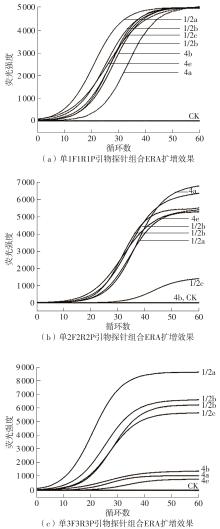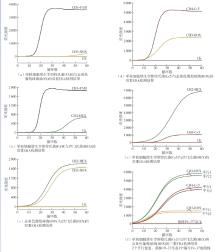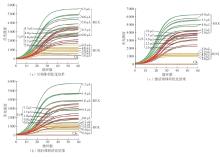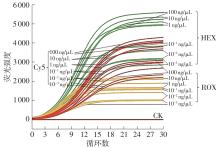| 1 |
闫琳,裴晓燕,彭子欣,等 .2019年中国市售水果干制品中微生物污染状况[J].卫生研究,2022,51(1):63-67.
|
|
YAN Lin, PEI Xiaoyan, PENG Zixin,et al .Microbial contamination in dried fruit products in China in 2019[J].Journal of Hygiene Research,2022,51(1):63-67.
|
| 2 |
王旭,刘奂辰,王丽明,等 .肠道类器官:评价肉与肉制品中食源性致病菌感染的新工具[J].肉类研究,2024,38(1):75-81.
|
|
WANG Xu, LIU Huanchen, WANG Liming,et al .Intestinal organoids:a new tool for infection assessment of foodborne pathogens from meat and meat products[J].Meat Research,2024,38(1):75-81.
|
| 3 |
吴玲玲,李艳芬,炊慧霞,等 .2017—2021年河南省肉与肉制品食源性致病菌监测及部分肠杆菌耐药特征分析[J].中国食品卫生杂志,2023,35(5):749-756.
|
|
WU Lingling, LI Yanfen, CHUI Huixia,et al .Prevalence of foodborne pathogens and antimicrobial resistance characteristics of Enterobacteriaceae in meat products in He’nan province from 2017 to 2021[J].Chinese Journal of Food Hygiene,2023,35(5):749-756.
|
| 4 |
CHIEFFI D, FANELLI F, FUSCO V .Antimicrobial and biocide resistance in Staphylococcus aureus:genomic features,decontamination strategies,and the role of S. aureus complex-related species,with a focus on ready-to-eat food and food-contact surfaces[J].Frontiers in Food Science and Technology,2023,3:1165871/1-21.
|
| 5 |
LI Q C, LI Y, TANG Y Y,et al .Prevalence and characterization of Staphylococcus aureus and Staphylococcus argenteus in chicken from retail markets in China[J].Food Control,2019,96:158-164.
|
| 6 |
TEKLEMARIAM A D, AL-HINDI R R, ALBIHEYRI R S,et al .Human salmonellosis:a continuous global threat in the farm-to-fork food safety continuum[J].Foods,2023,12(9):1756/1-26.
|
| 7 |
XIAO X N, WANG W, ZHANG J M,et al .A quantitative risk assessment model of Salmonella contamination for the yellow-feathered broiler chicken supply chain in China[J].Food Control,2021,121(6):107612/1-9.
|
| 8 |
LIU Y T, SUN W X, SUN T M,et al .The prevalence of Listeria monocytogenes in meat products in China:a systematic literature review and novel meta-analysis approach[J].International Journal of Food Microbiology,2020,312:108358/1-9.
|
| 9 |
郝歌,钱映,李蓉,等 .单核细胞增生李斯特菌毒力基因及其致病机制的研究进展[J].中国食品卫生杂志,2023,35(3):481-486.
|
|
HAO Ge, QIAN Ying, LI Rong,et al .Research pro-gress on virulence genes and pathogenesis of Listeria monocytogenes [J].Chinese Journal of Food Hygiene,2023,35(3):481-486.
|
| 10 |
LAMOND N M, MCMULLEN P D, PARAMASVARAN D,et al .Cardiotropic isolates of Listeria monocytogenes with enhanced vertical transmission dependent upon the bacterial surface protein InlB[J].Infection and Immunity,2021,89(2):e00321-20/1-33.
|
| 11 |
食品安全国家标准 预包装食品中致病菌限量: [S].
|
| 12 |
王丹丹,刘鸣畅,杨艳歌,等 .食源性致病菌快速检测技术研究进展[J].食品科学,2022,43(3):276-285.
|
|
WANG Dandan, LIU Mingchang, YANG Yange,et al .Recent progress in technologies for rapid detection of foodborne pathogens[J].Food Science,2022,43(3):276-285.
|
| 13 |
DUBOVITSKAYA O, SEINIGE D, VALERO A,et al .Quantitative assessment of Campylobacter spp. levels with PCR methods at different stages of the broiler food chain[J].Food Microbiology,2023,110:104152/1-8.
|
| 14 |
于继彬,李俊,马陈翠,等 .一种常温核酸扩增反应:CN109971834A[P/OL].2022-11-25.
|
| 15 |
王帅,杨艳歌,吴占文,等 .重组酶聚合酶扩增、重组酶介导等温扩增及酶促重组等温扩增技术在食源性致病菌快速检测中的研究进展[J].食品科学,2023,44(9):297-305.
|
|
WANG Shuai, YANG Yange, WU Zhanwen,et al .A review of the application of recombinase polymerase amplification,recombinase-aided amplification and enzymatic recombinase amplification in rapid detection of foodborne pathogens[J].Food Science,2023,44(9):297-305.
|
| 16 |
林志伟,王帅,王迎春,等 .婴儿配方乳粉中食源性致病菌双重ERA快速检测方法的建立[J].食品科学,2023,44(18):347-354.
|
|
LIN Zhiwei, WANG Shuai, WANG Yingchun,et al .Establishment of a dual enzymatic recombinase amplification method for rapid detection of foodborne pathogens in infant formula powder[J].Food Science,2023,44(18):347-354.
|
| 17 |
王亚磊 .基于免疫磁分离的金黄色葡萄球菌RPA-LF快速检测方法的建立[D].北京:中国农业科学院,2019.
|
| 18 |
杨艳歌,王帅,李红娜,等 .沙门氏菌ERA可视化快速检测方法的建立[J].中国食品学报,2023,23(10):261-272.
|
|
YANG Yange, WANG Shuai, LI Hongna,et al .Establishment of ERA visual rapid detection methods for Salmonella [J].Journal of Chinese Institute of Food Science and Technology,2023,23(10):261-272.
|
| 19 |
王金凤,刘立兵,耿云云,等 .单核细胞增生李斯特氏菌实时荧光RPA检测方法的建立及应用[J].现代食品科技,2018,34(8):213-218,98.
|
|
WANG Jin-feng, LIU Li-bing, GENG Yun-yun,et al .Development and application of the recombinase polymerase amplification assay for detection of Listeria monocytogenes [J].Modern Food Science and Technology,2018,34(8):213-218,98.
|
| 20 |
郭正洋,陈晶,刘小青,等 .单核细胞增生李斯特氏菌荧光RPA快速检测方法的建立[J].基因组学与应用生物学,2020,39(12):5599-5605.
|
|
GUO Zhengyang, CHEN Jing, LIU Xiaoqing,et al .Development of fluorescence recombinase polymerase amplification for the rapid detection of Listeria monocytogenes [J].Genomics and Applied Biology,2020,39(12):5599-5605.
|
| 21 |
崔荣飞,赵义良,田梅,等 .重组酶介导扩增技术快速检测食品中单核细胞增生李斯特菌[J].食品安全质量检测学报,2021,12(5):1773-1777.
|
|
CUI Rong-fei, ZHAO Yi-liang, TIAN Mei,et al .Rapid detection of Listeria monocytogenes by recombinase aided amplification method[J].Journal of Food Safety & Quality,2021,12(5):1773-1777.
|
| 22 |
食品安全国家标准 食品微生物学检验总则: [S].
|
| 23 |
出口食品中食源性致病菌检测方法 实时荧光PCR法: [S].
|
| 24 |
范春梅,宋阳,张誉,等 .2017—2022年四川省生肉中常见致病菌污染状况调查研究[J].预防医学情报杂志,2024,40(4):404-408,417.
|
|
FAN Chunmei, SONG Yang, ZHANG Yu,et al .Investigation on contamination of common pathogenic bacteria in raw meat in Sichuan Province from 2017 to 2022[J].Journal of Preventive Medicine Information,2024,40(4):404-408,417.
|
| 25 |
宁雪,赵丽娜,张晨,等 .2019 —2021年上海进口肉类及水产品食源性致病菌污染状况分析[J].食品安全导刊,2022,341(12):61-67.
|
|
NING Xue, ZHAO Lina, ZHANG Chen,et al .Contamination analysis of food-borne pathogen from imported meat and aquatic products in Shanghai from 2019 to 2021[J].China Food Safety Magazine,2022,341(12):61-67.
|
| 26 |
郑金华,宋浩,宋伟 .2019—2021年山东省泰安市肉与肉制品致病菌污染状况检测分析[J].预防医学论坛,2023,29(5):355-357,367.
|
|
ZHENG Jin-hua, SONG Hao, SONG Wei,et al .Detection and analysis of pathogenic bacteria contamination in meat and meat products in Tai’an city,Shandong Pro-vince from 2019 to 2021[J].Preventive Medicine Tribune,2023,29(5):355-357,367.
|
| 27 |
王宇,孙嘉蕾,韩雪 .嗜冷菌的嗜冷机制及其应用研究进展[J].食品研究与开发,2020,41(12):196-201.
|
|
WANG Yu, SUN Jia-lei, HAN Xue,et al .Progress in the mechanism and application of psychrophilic bacteria[J].Food Research and Development,2020,41(12):196-201.
|
| 28 |
GAO X K, LIU H H, WANG T T,et al .Low temperature preservation for perishable ready to eat foods:not entirely effective for control of L.monocytogenes [J].Trends in Food Science & Technology,2023,142:104228/1-9.
|











